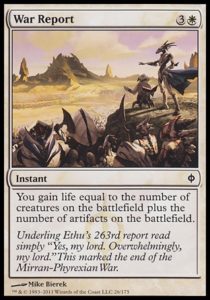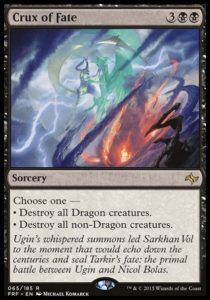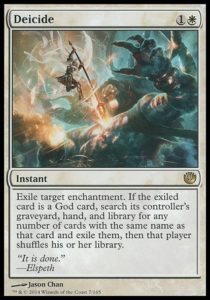Yesterday, Mark Rosewater’s annual State of Design article arrived, and it once again gave us a look behind the majestic cardboard game which we all know (and many of us love). It’s unsurprising that a designer will take and give credit for a year’s successes, but rare that one will readily acknowledge and accept criticism, even for a successful product. Apparently, most of the biggest issues of the year were with Dragons of Tarkir:
- It followed the dragon-heavy Fate Reforged, which sapped it of uniqueness.
- Its dragons felt too same-y, particularly because (due to story reasons), there could be no small dragons.
- Its design was complacent; dragons were expected to be a huge selling but weren’t as popular as expected.
- Megamorph was a generally disliked mechanic, not in the sense of infect (which is loved and loathed by vocal minorities), but in that few people seemed to like the mechanic, even if they appreciated its gameplay.
- Dragons should have been the first set, not the last; people preferred Khans of Tarkir’s Warlord Wedge World to Dragons of Tarkir’s Dragon Tyrant World, and the former now never existed. (I suspect that people would be grumbling if the dragon world were wiped from the timeline instead, but Khans did execute on wedges, something more unique/unusual than dragons, which are in every block.)
I think that the last point is particularly fascinating. Consider this quote from the article:
Long ago, we saw mechanics as disposable; we then came to realize that they were valuable tools we could reuse. I think in many ways we used to see worlds in the same way. We visit and move on. But now we’re realizing we’ve built cool places we want to go back to. That gets us to this problem. We made a very compelling world that players fell in love with, and then we changed it to a less compelling world forever. Now, I don’t believe we thought we were doing that.
Wizards has largely been employing what I’d call a FEU (F^$% Everything Up) mentality when it makes worlds. We are introduced to a cool, conflicted world which ends the block not merely different, but horribly mangled or drastically changed, often devoid of what made it unique or interesting in the first place. This wasn’t problematic in the early days of Magic (when most stories took place across various parts and time periods of Dominaria) or its middle days (when every block took us to a new plane). However, now that we’re regularly returning to planes, this is a major problem; not necessarily for storylines, since many are amazing, but for players’ desire to revisit these words.
Let’s look backwards to see how easy it would be to return to planes.
Planes in green were introduced as one thing and concluded their block as the same thing (or close enough). They should be easy to return to.
Planes in red underwent a dramatic shift by the end of the block. They would be difficult or impossible to return to, as introduced.
Planes in orange are Innistrad and Lorwyn-Shadowmoor. They have been substantially changed, but are recognizably themselves.
- 2003: Mirrodin, Artifact World, survived Memnarch’s tyranny and the rise of the green sun.
- 2004: Kamigawa, Spirit World, endured the Kami War. As far as I know, it’s intact and back to the status quo, though its low popularity makes it unlikely to return as a Standard set.
- 2005: Ravinca, Guild World, ended with the block with the dissolution of the Guildpact and the destruction of the guild system. Guild World became guildless.
- 2006: Time Spiral all but destroyed Dominaria. The world of Antiquities, Ice Age, Invasion, and Odyssey finally met an Apocalypse it couldn’t beat. Most of Dominaria seems to have been rendered into a sand-whipped wasteland.
- 2007: Lorwyn, Celtic Faerie Tale World, transformed into Shadowmoor, Evil Reflection/Hybrid World. I think that at the end of Eventide, the Great Aurora was ended, so it’s unclear what Lorwyn-Shadowmoor look like (though they could still be recognizably themselves).
- 2008: Alara, Shard World, was fused into one plane. Shard world became shardless.
- 2009: Zendikar, Adventure/Land World ended its block doomed, being consumed by unstoppable nightmarish monster-gods.
- 2010: Mirrodin, was destroyed and remade into New Phyrexia. While New Phyrexia is ripe for return, Mirrodin is gone.
- 2011: Innistrad, Gothic Horror World survived its block… sort of. The world was one where humans were outnumbered and overwhelmed by monsters. By block’s end, Innistrad’s humans were saved, its literal guardian angel had returned, and the monsters were beaten back (with its werewolves entirely gone).
- 2012: Ravinca, Guild World, returned. With some hand-waving, the guilds actually never went away and by block’s end, the Guildpact was restored. The storyline of the block essentially undid the destruction of 2006’s Dissension.
- 2013: Theros, Greek/Enchantment World returned to its status quo by block’s end.
- 2014: Tarkir (Khans version) was erased from the timeline entirely, giving it the most difficult-to-retcon-or-undo ending ever.
- 2015: Tarkir (Dragons version) is here to stay.
It’s worth noting that of the three returnable worlds which predate the Return-To era, Mirrodin is now gone and Lorwyn and Kamigawa are likely too unpopular to return to (in a Standard format, as the sole plane—I happily acknowledge Planechase 2012 and Magic Origins). So, they’re all at least Orange worlds by now. That leaves us with few green worlds, essentially only planes from the last four years.
Wizards is clearly trying to make its most recent worlds easier to return to, as seen by Ravnica and Theros being left recognizably the same by block’s end. It’s also placing a greater emphasis on story, which has made for some spectacular cards and some of the best communicated-through-cards tales in Magic’s history. This comes with the consequence of occasionally erasing a warlord plane from history or unleashing world-devouring Eldrazi, but it makes for a great product.
Moreover, red worlds aren’t off-limits. While Battle for Zendikar will likely have a very different feel than 2009’s Zendikar (we’re probably not seeing tribal conflict in adventure world, but the continuation of Rise of the Eldrazi’s battle between a united world and nightmare gods in the ruins of Zendikar’s adventure world), it’s a continuation of the excellent story left dangling for five years. It wouldn’t be hard for Wizards to create a new conflict on Innistrad (I’d expect to see that in the new few years), sunder Alara again (maybe), or reginite the battle for Mirrodin (unlikely, since Phyrexians are too good villains to make homeless again).
While I regret that it’ll require a new world or a major retcon for us to see Wedge world again (it’s particularly weird that the worlds which name both the wedges and the shards no longer exist), I look forward to Wizards continuing to provide ever more creative worldbuilding. …especially since they’re going to try to be extra-careful to not FEU Forever from here on out. And as always, thanks for reading.
—Zachary Barash
Zachary Barash has been playing Magic on and off since 1994. He loves Limited and drafts every available format (including several that aren’t entirely meant to be drafted). He’s a proud Cube owner, improviser, and game designer. He has an obsession with Indian food that borders on being unhealthy.




